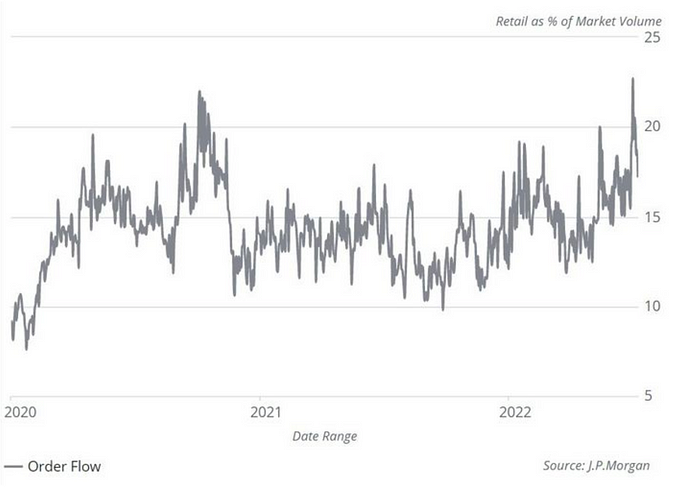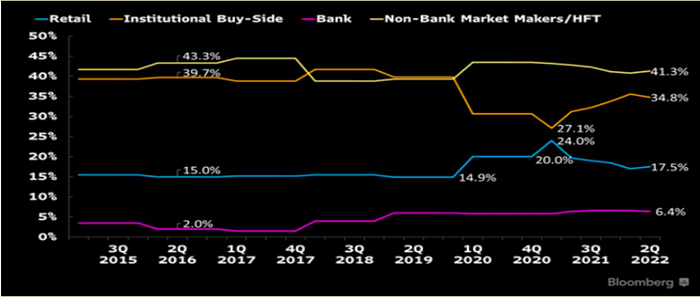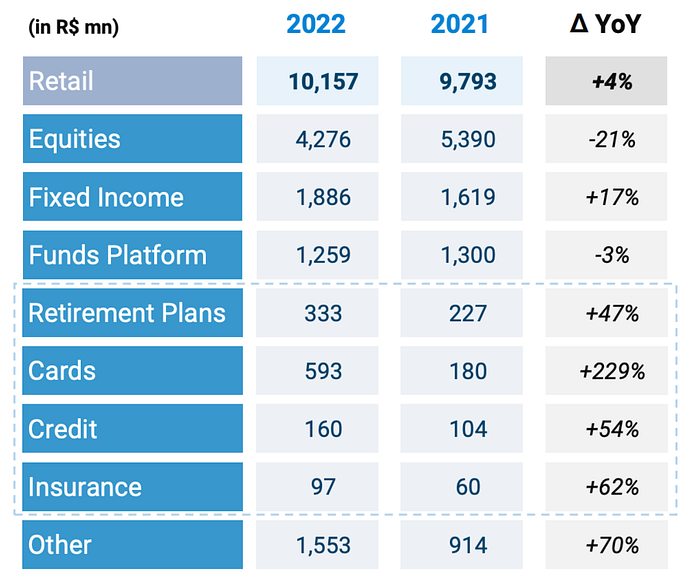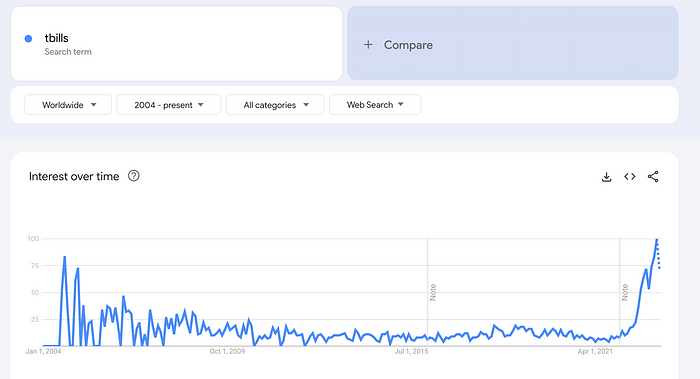Two years ago I wrote about the retail investing zeitgeist that was sweeping the globe. Today, the zeitgeist is still alive. In Q1 2023, retail investing levels hit another all time record, beating out pandemic highs:
Total trading volume coming from retail investors was about 23% from January 25 to February 1, JPMorgan’s Peng Cheng wrote in a note to clients this week, narrowly edging out the record retail share of 22% in the pandemic-fueled trading frenzy and a massive increase in retail volumes since late last year, when it hovered at about 15%. source
Retail investing’s continued heights show it was a strong wedge into the successful neobank path for those that ramped up in 2021. Companies that executed well the last few years still have a chance at becoming a successful (neo)bank.

So, why are retail investing levels still so elevated? A few short answers:
- 2022 was the worst year for the stock market since the last recession. Growth from lows is still growth to investors.
- Inflation is cooling, giving retail optimism
- There are still large excess income holdings at every income level post pandemic
- Q4 corporate earnings largely fell short of Wall Street’s worst fears
- Uncertainty and volatility present an investing opportunity
- Crypto hit a bottom in late 2022 and many retail investors are also crypto hodl*ers
- Consumer is more volatile and consumer stocks react faster to pullbacks than enterprise stocks. US big cap consumer volatility is 60–200% higher than NASDAQ averages. Retail investors are more interested in consumer brand name stocks like Apple, Tesla, etc.

Let’s dig into reason #3, as from conversations with wealth management insiders, this is not well known: The Federal Reserve released a report last fall showing that consumers largely used the stimulus checks to pay off credit card debt, reducing the household income to debt ratio. After that, consumers were still left with hundreds of billions of excess income compared to pre-pandemic levels: $1.3T as of mid 2022 and estimated to be $900B in Q1 of 2023. Dwindling, but still elevated.
So, 1) consumers did not waste the stimmy checks as was speculated and 2) there is still large pent up excess savings that are contributing to people self-actualizing and expressing their identity through retail investing.
This bucks the conventional wisdom that consumer fintechs like Robinhood were solely elevated as zero interest rate phenomena — fueled by investors seeking higher returns in equities since high yield accounts weren’t an option. Today’s investing is not all AMC-Gamestop fueled mania. Neobroker apps suffered in H2 2022, but their market is coming back, and it’s not just because their users can’t earn money elsewhere.

So what does this mean? A few theories and what we’re watching:
Neobrokers are becoming neobanks
Funny enough, the 2022 downturn may prove to be the best thing to ever happen to neobanks. It forced them to add new products, cross-sell clients, and diversify revenue streams. Many expanded into offering mutual funds, fixed income, spend cards, checking, retirement assets, and more.
Neobanks and neobrokers that make it out of the woods will be those that did cross-sell well. Just look at this YoY product mix shift from XP, a leading investments platform in Brazil. What doesn’t kill you, makes you stronger. Never let a good crisis go to waste.

Embedded fintech companies are a huge beneficiary
One of the biggest winners from neobanks expanding their product set are embedded fintech companies. Neobanks want to add products, but want to test doing so in a lean manner. Cue embedded fintech providers who help them get up and running easily. There is real graduation risk for those players, as neobanks learn to do it themselves and move to more barebones api rails, but there is a revenue opportunity in the meantime. Embedded fintechs should strike now, while retail investment interest is still very high.

Investment interest spreads to fixed income
The retail investing zeitgeist was initially all about equities. We saw it expand to crypto, real estate, and collectibles (NFTs, shoes, sports cards, luxury bags) in 2021. In 2023, it is expanding to fixed income (t-bills, corporate bonds, treasuries) and structured products (indices, ETFs, and options). Public.com has been a leader in adding this.
Fixed income embedded providers are exploding. It makes sense: the fixed income market lagged equities in both retail interest (low rates) and therefore, technical evolution. Fixed income will get its 21st century upgrade in the next 2–3 years as infrastructure players upgrade execution, settlement, and dexterity of offerings.
SVB is doing for fixed income what the pandemic did for equities. TBills are fixed income’s AMC / GameStop. What will be its Robinhood (trading platform)? What will be its Drivewealth / Apex infra layer?

Neobroker apps will revive
Robinhood’s growth slowed throughout 2022. The industry-wide phenomenon affected neobrokers globally. Those players spent the time investing in adding yield bearing deposits and other products. I expect we’ll see last quarter’s uptick in both equities and crypto volumes reflected in neobroker’s earnings reports. Revenue may also be higher as many neobrokers added interest bearing products.
We’ve hit a bottom — not THE bottom
I don’t have a crystal ball but it does feel like at least from a retail investing activity perspective, we hit a bottom in late 2022 and are coming out of it. There will very likely be more bottoms ahead given the number of recent bank failures. We are not out of the recession woods. But something has changed, and some retail investors now see a light at the end of the tunnel, leading to increased retail investing activity. Crypto prices also reflect this.
At Lightspeed we believe that the successful consumer neobank path looks like this:
- Find a wedge: one with strong cultural tailwinds and a business model change, and low CAC
- Exhibit signs of primary account usage for that initial wedge: strong engagement and transaction/deposit activity retention
- Ride that first product’s success for few years to ~$50M+ sales
- Use the time and capital to acquire licenses
- Expand product offerings (find big profit pool if haven’t already)
- Win share of wallet
- Realize the full vision as a primary account for multiple products
2023 is the year that neobanks and neobrokers can capitalize on the moment and take steps 4–7 to achieve the neobank dream. At Lightspeed we’re fond of saying race cars overtake one another on curves, not straightaways. Today’s environment — since the second half of 2022 onward — has presented a curve that someone will use to take a lead.
A product that leverage’s retail investment can still be that wedge. It probably will not look like the models of the last decade — probably not another fractional equities investing product monetizing through PFOF.
Indeed, we are already seeing exciting innovations in embedded fixed income, bill pay, shareholder activation, strategic tax and wealth advisory, and more.
The US continues to have the most robust capital markets environment in the world. The retail trading phenomenon only underscores this further. The US is a highly individualistic society. Everyone has the American dream of making it rags to riches — and the flip the last few years from retail investing being solely for financial gains to being an act of identity, belonging, and entertainment, convinces me that America will continue to be a very special market for retail investing for the foreseeable future.
If you’re a founder building on the back of these trends, please don’t hesitate to reach out: mbent@lsvp.com
This is the first post in a series highlighting Consumer Fintech in the Americas, with a focus on the US retail capital markets trends. Expect more to come, highlighting consumer fintech trends in the USA, Brazil, and Mexico.
Authors




